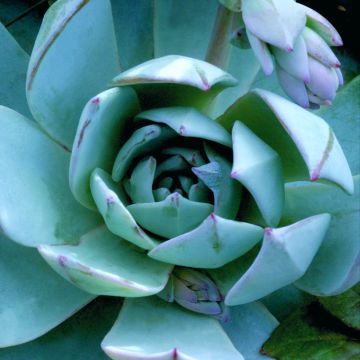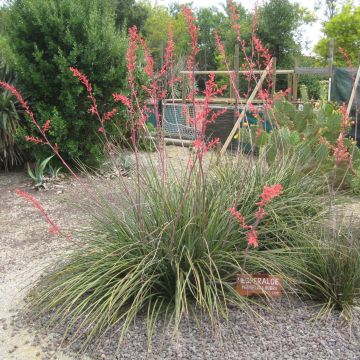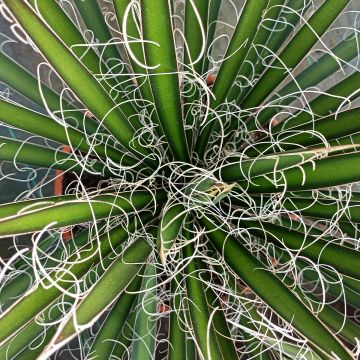

Echeveria lilacina


Echeveria lilacina


Echeveria lilacina


Echeveria lilacina
Echeveria lilacina
Echeveria lilacina
Ghost Echeveria, Mexican Hens and Chicks
This item cannot be shipped to the selected country
Delivery charge from €5.90
More information
Delivery charge from €5.90
More information
Schedule delivery date,
and select date in basket
This plant carries a 12 months recovery warranty
More information
We guarantee the quality of our plants for a full growing cycle, and will replace at our expense any plant that fails to recover under normal climatic and planting conditions.
From €5.90 for pickup delivery and €6.90 for home delivery
Express home delivery from €8.90.
Does this plant fit my garden?
Set up your Plantfit profile →
Description
Echeveria lilacina, also known as the 'Ghost Echevaria', is a small succulent well known for its rosette of very light blue almost silver leaves, regular, very compact and of good size. This creeping perennial owes its unique colouration to the white to grey pruine that covers its wide fleshy leaves, thick, flat and spoon-shaped. With the sun, the edges of its foliage blush beautifully, perfectly matching its summer flowering in short arched spikes of small pinkish-orange bells. Not very hardy and highly drought resistant, it is a plant that is ideally suited to rockeries in Mediterranean gardens or that can be used to create fantastic and easy to maintain pots.
Echeverias are succulent perennials belonging to the family of Crassulaceae, famous for their compact rosettes of very graphic leaves. Native to dry and rocky areas of central Mexico, it is a genus that especially fears excess water, requiring well-drained mineral soil and a highly sunny exposure. Highly drought resistant, Echeveria grows better with a few waterings in summer. The plant tolerates little frost (up to -5°C (23°F)) and is mainly cultivated in pots that are stored indoors away from frost, from the end of autumn. Some privileged corners in the Mediterranean region can still accommodate this plant in dry rockeries and slopes.
Echeveria lilacina is a botanical species distinguished by its perfect rosette of large, widely flattened leaves, covered with a pruine that gives it a very light blue colour. It is a perennial succulent plant with a regular and compact solitary rosette habit at the end of a short stem that reaches a maximum height of 5cm (2in) and remains barely visible under its dense foliage. Slow growing, it only reaches a height of 15cm (6in) and a maximum spread of 25cm (10in). The leaves are fleshy, thick, flat, wide, spoon-shaped, and have small points. The flowering takes place in late spring or early summer, from March to June. It takes the form of clusters of bright pinkish-orange bells, carried at the axils of the leaves, on short erect and then arched spikes of 15cm (6in).
Plant Echeveria lilacina in the rockery, on a well-drained slope, or at the edge of a bed if your garden is located by the sea, where frosts do not exceed -5°C (23°F), alongside the Cape Aster Felicia amelloides, Delospermas, and purslanes that appreciate the same conditions. Elsewhere, you can plant it in a nice pot or container, alone or in combination with other Echeverias or other succulent plants such as Sempervivums, for example.
Echeveria lilacina in pictures


Flowering
Foliage
Plant habit
Botanical data
Echeveria
lilacina
Crassulaceae
Ghost Echeveria, Mexican Hens and Chicks
North America
Other Echeveria
Planting and care
Planting period
Intended location
Care
This item has not been reviewed yet - be the first to leave a review about it.
Cacti and succulents
Haven't found what you were looking for?
Hardiness is the lowest winter temperature a plant can endure without suffering serious damage or even dying. However, hardiness is affected by location (a sheltered area, such as a patio), protection (winter cover) and soil type (hardiness is improved by well-drained soil).

Photo Sharing Terms & Conditions
In order to encourage gardeners to interact and share their experiences, Promesse de fleurs offers various media enabling content to be uploaded onto its Site - in particular via the ‘Photo sharing’ module.
The User agrees to refrain from:
- Posting any content that is illegal, prejudicial, insulting, racist, inciteful to hatred, revisionist, contrary to public decency, that infringes on privacy or on the privacy rights of third parties, in particular the publicity rights of persons and goods, intellectual property rights, or the right to privacy.
- Submitting content on behalf of a third party;
- Impersonate the identity of a third party and/or publish any personal information about a third party;
In general, the User undertakes to refrain from any unethical behaviour.
All Content (in particular text, comments, files, images, photos, videos, creative works, etc.), which may be subject to property or intellectual property rights, image or other private rights, shall remain the property of the User, subject to the limited rights granted by the terms of the licence granted by Promesse de fleurs as stated below. Users are at liberty to publish or not to publish such Content on the Site, notably via the ‘Photo Sharing’ facility, and accept that this Content shall be made public and freely accessible, notably on the Internet.
Users further acknowledge, undertake to have ,and guarantee that they hold all necessary rights and permissions to publish such material on the Site, in particular with regard to the legislation in force pertaining to any privacy, property, intellectual property, image, or contractual rights, or rights of any other nature. By publishing such Content on the Site, Users acknowledge accepting full liability as publishers of the Content within the meaning of the law, and grant Promesse de fleurs, free of charge, an inclusive, worldwide licence for the said Content for the entire duration of its publication, including all reproduction, representation, up/downloading, displaying, performing, transmission, and storage rights.
Users also grant permission for their name to be linked to the Content and accept that this link may not always be made available.
By engaging in posting material, Users consent to their Content becoming automatically accessible on the Internet, in particular on other sites and/or blogs and/or web pages of the Promesse de fleurs site, including in particular social pages and the Promesse de fleurs catalogue.
Users may secure the removal of entrusted content free of charge by issuing a simple request via our contact form.



















































